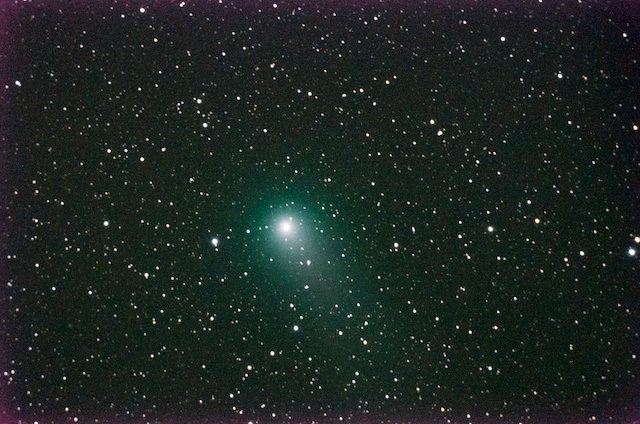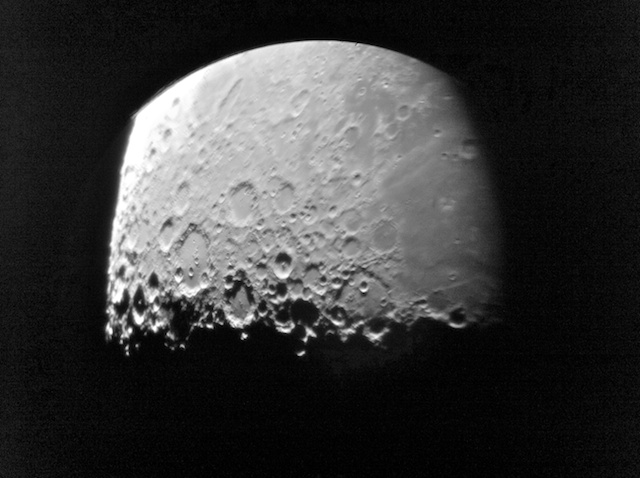
iPhone & D7000 Astrophotography: Planets, DSOs, Moon
Posted: 20 September 2011![[Home!]](../../../../../etx/images/mighty_etx_logo_orig-sm.jpg)
 |
iPhone & D7000 Astrophotography: Planets, DSOs, MoonPosted: 20 September 2011 |
![[Home!]](../../../../../etx/images/mighty_etx_logo_orig-sm.jpg) |
| Follow @mweasner | Welcome | Photos | Videos | Equipment | Links | Data |
Opened the observatory at 1806 MST, 97°F, under clear skies, for what turned out to be a nearly 8 hour session. At 1812 MST, viewed Venus, very low in the western sky, at 77X in the 8" telescope. I quickly set up for iPhone afocal imaging. This photograph was taken with the Apple Camera app at 222X on the 8" LX200-ACF:

After I ended the iPhone imaging, I continued to view Venus until 1834 MST, shortly after sunset. I then slewed to Saturn; it was faintly visible at 77X. At 1855 MST, I ended viewing and began setting up for D7000 DSLR astrophotography. I added the focal reducer. At 1925 MST, about an hour after sunset, I could see the M101 galaxy supernova in the 26mm eyepiece. The galaxy itself was just barely visible against a still-bright sky. I attached the D7000 DSLR at prime focus + focal reducer + Off-Axis Guider (OAG) and did a focus test on the star Arcturus using the Bahtinov Mask. I then returned to M101 and did several framing test exposures. I located a very faint guidestar but as it turned out, it was too faint to reliably see in the illuminated reticle eyepiece. So, here is one of the 2 minute, ISO 6400, unguided, framing test exposures, slightly cropped:

The supernova is the bright star in the center of the frame, about 5 o'clock from the galaxy's nucleus. If you need further assistance is identifying the supernova, see the M101 image I took on 29 August 2011. Shortly after taking the D7000 supernova images, I posted this iPhone photograph of the D7000 screen on Twitter:

One person wondered if this was the first image of a supernova "taken" by an iPhone. It may well be!
I removed the focal reducer, did a focus test on the star Altair, and begin framing tests of the galaxy NGC7331. I was able to find an excellent guidestar. Here is a 10 minute, ISO 6400, cropped image of NGC7331:

If you look closely, you will see four other small faint galaxies in the frame.
At 2107 MST, slewed the telescope to Comet C/2009 P1 (Garradd) and began imaging it with the D7000 DSLR. This is a 5 minute, ISO 6400, guided exposure:

I ended imaging at 2134 MST, unmounted the camera and added the focal reducer and visual back to the 8" telescope. I then viewed the comet with the focal reducer + 40mm eyepiece; the low magnification provided a very nice and bright view of the comet coma and tail.
I then began some iPhone imaging attempts of M13, globular cluster, afocal, focal reducer + 40mm eyepiece. I used the star Vega to align the camera and eyepiece optics, since it was easily seen on the camera screen. Using the "Slow Shutter" app, 30 second, EV+2.0, exposure, the globular cluster is just visible right of center in this image:

I actually took several images with the intention of stacking them. However, the noise in the images was too great and the stacked image was not good.
At 2235 MST, slewed to M45, the Pleiades, for some more iPhone DSO imaging attempts, afocal, focal reducer + 40mm eyepiece. This image of the brighter stars in a portion of the Pleiades was taken using the Apple "Camera" app:

This image was taken with the "Slow Shutter" app, 30 seconds, EV+2.0:

More stars are visible in the image but no nebulosity. I did several exposures but stacking did not bring out any nebulosity.
I tried using the "Slow Shutter Cam" app for both M13 and M45 but the results were not good.
I ended iPhone DSO imaging at 2310 MST. I removed the focal reducer but continued to use the visual back. The eastern sky was beginning to brighten from the rising Last Quarter Moon. I went to Jupiter, high in the eastern sky. At 77X, the four Galilean Moons were visible. Seeing was not too bad and a lot of details were seen in the cloud bands, including the Great Red Spot. The best view was at 206X. At 2335 MST, I began iPhone imaging of Jupiter. Here is a single frame from an afocal video, 222X:

The planet is overexposed, but the moons (left to right) are easily seen: Io, Europa, Callisto, and Ganymede. This image of Jupiter, showing several clouds bands and the Great Red Spot (faintly visible in the middle of the bottom equatorial belt), was taken with the "Camera" app, 666X, Moon Filter:

At 0019 MST, I went to the moon but it was still in some tree branches. At 0041 MST, I began doing some iPhone imaging of the moon. First, are some 222X images:



I finished with this 77X image:

At 0100 MST, I did some lunar observing at 77X, 133X, 206X, and 364X. The moon was still a little too low in the sky for good seeing but there were still lots of fascinating views along the terminator, with some great shadows. The best view was at 206X. At 0130 MST, I returned to Jupiter, nearing the zenith. The details in the clouds bands when using the 9.7mm (206X) eyepiece were very impressive.
After a long but very enjoyable night, the observatory was closed at 0155 MST, 72°F.
Go to the previous report.
Return to the Cassiopeia Observatory Welcome Page.